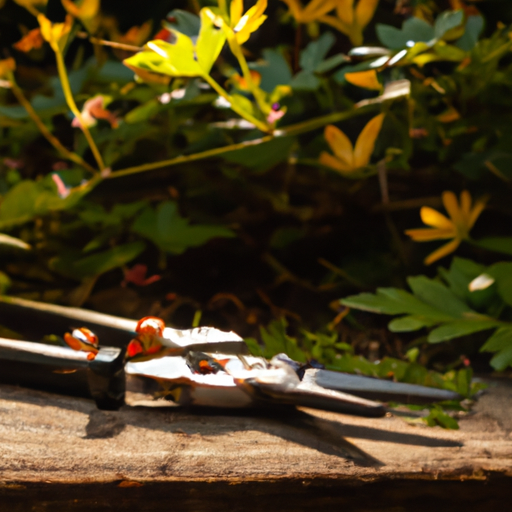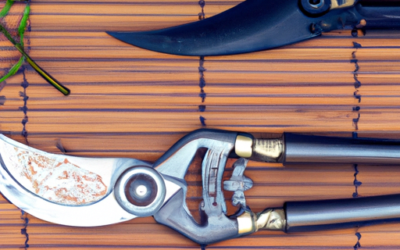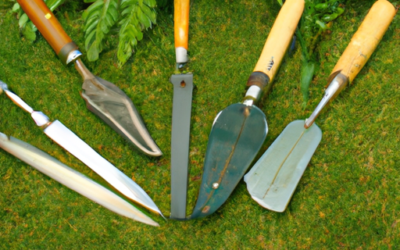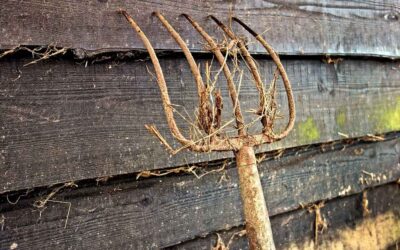Embrace the art of perfect pruning with Japanese secateurs, your new gardening essential. This handy tool is the go-to choice for horticulture enthusiasts and professional plant caretakers globally and for a good reason. Seen as more a piece of artistry than a mere tool, the Japanese secateurs (or hand pruners) come with an interesting tale and a promise to change your gardening game for good. In the wholesome journey ahead, you’ll discover why this elegant tool has such a following, and how you can identify a quality pair that’s just right for you. Enjoy this rich blend of tool history, garden wisdom, and smart buying tips that transforms you from an amateur plant lover to a discerning, aware consumer.
Understanding the Importance of Quality Gardening Tools
Gardening can be a great source of joy, and for this art to truly flourish, you need the right tools to accompany you on your journey. But it’s not just about having any tool, it’s about investing in quality ones.
Role of Gardening Tools in Plant Health
Just like how a painter values his brushes, every gardener understands the significance of their gardening tools in maintaining plant health. The right tool can make all the difference in trimming just enough stem, tilling the soil perfectly, or cutting precisely without causing harm to your plants.
Effects of Using Low-Quality Tools
While it might be tempting to save some money by opting for low-quality tools, this can actually do more harm than good. Low-quality tools are more likely to be inefficient, causing unnecessary stress to your plants. Additionally, they tend to wear out quickly and frequently require replacements.
Benefits of Investing in Quality Tools
High-quality gardening tools may initially seem expensive, but investing in them offers long-term benefits. They are crafted to last for years and come with improved functionality, helping you to maintain your garden effectively and efficiently, thereby enhancing the overall health and beauty of your garden.
What Makes Japanese Secateurs Special
Out of the multitude of gardening tools, one that stands out distinctly is Japanese Secateurs. They aren’t just another pruning tool, rather they convey a heritage of exquisite Japanese craftsmanship.
Tradition of Japanese Craftsmanship
Japanese craftsmanship is renowned for its incredible attention to detail, providing a balanced blend of form and function. Japanese Secateurs reflects this tradition, crafted with precision that goes beyond cutting stems and branches, it furthers the gardeners’ connection with nature.
Unique Features of Japanese Secateurs
What sets Japanese secateurs apart are their unique features. Unlike regular pruners, they have renowned sharpness, consistent smoothness in cut, and great durability. They are usually lighter and more compact, making them easier to handle, even for long gardening sessions.
Comparison of Japanese Secateurs and Regular Secateurs
When comparing regular secateurs with their Japanese counterparts, the difference is clear in their quality and performance. Japanese secateurs offer precise cuts without crushing plant tissues, unlike some regular secateurs. This is because of their slim, razor-sharp blades that are designed for clean and easy cuts.
Necessity of Japanese Secateurs for Your Gardening
The notion of using Japanese secateurs may seem intimidating to some, but once you understand their distinct benefits, you’ll appreciate them as a valuable companion in your gardening journey.
Improving Precision in Gardening Tasks
One of the main reasons to use Japanese secateurs lies in their capacity to enhance the precision of your work. The high-quality steel blades ensure every cut is clean and precise, eliminating the possibility of ragged cuts that can damage the plant.
Enhancing Comfort and Ease in Gardening
Another notable benefit is the elevated comfort and ease they offer. Japanese secateurs are often ergonomically designed to fit in the hand comfortably, reducing the strain on the hand and wrist during extended use.
Long-Term Savings with Japanese Secateurs
While Japanese secateurs may seem a bit pricey initially, but they can actually prove to be a cost-effective investment in the long run. Thanks to their durability and quality, these tools can endure plenty of use over time, reducing your need for frequent replacements.
Choosing the Right Type of Japanese Secateurs
There is no one-size-fits-all when it comes to choosing the right Japanese secateurs. This decision depends on multiple factors, including your specific gardening needs, your comfort, and the nature of the tasks at hand.
Different Types of Japanese Secateurs
There are several types of Japanese secateurs, with the key differences lying in their design and purpose. Some are designed for fine pruning tasks, while others are more suitable for tougher, heavier jobs.
Assessing Your Gardening Needs
It’s important to take a step back and assess your gardening needs before choosing a Japanese secateur. Take into consideration the types of plants you have in your garden, the tasks you frequently undertake, and the kind of cuts these tasks require.
Choosing the Suitable Type for Your Tasks
Once you’ve assessed your needs, it’s time to match them with suitable secateurs. For example, bypass secateurs, which operate like a scissor, are perfect for precise, clean cuts on live wood, while anvil secateurs, with a straight upper blade that closes onto a flat lower one, are great for thicker, dead branches.
Understanding Blade Quality and Material in Japanese Secateurs
One of the most critical aspects in choosing secateurs is understanding the quality and material of the blade. It is the element that does the actual cutting, so it is crucial for it to be sharp, durable, and rust-resistant.
Materials Used in Japanese Blades
Japanese blades are typically made from high-quality carbon steel, which is known for its durability and excellent cutting performance. Some may also be made from stainless steel which is great for rust resistance.
Importance of Blade Quality
The quality of the blade determines how effective the secateur will be. A high-quality blade ensures clean and precise cuts, minimizing the damage to the plant tissue and making gardening efforts more efficient.
Assessing Blade Sharpness and Durability
It’s important to check for blade sharpness and durability. A sharp blade should work seamlessly through branches without causing frayed cuts. Durability is assessed by the toughness of the steel used and confirmed by the surety that the secateur will withstand frequent use without bluntness or breakage.
Evaluating Handle Design and Comfort in Japanese Secateurs
While it’s vital to consider blade quality and material, do not underestimate the impact of handle design on your gardening experience. The handle of your secateurs can significantly influence your comfort and efficiency during long gardening sessions.
Role of Handle Design in Efficiency and Comfort
The handle design plays a critical role in how well the secateurs perform. Ergonomically designed handles fit your hand nicely, reduce wrist strain, and can greatly improve your overall comfort and efficiency.
Materials Used for Handles
Secateur handles are often made from various materials, including metal, plastic, and even wood. Each has its own advantages. For example, metal handles are strong and durable, while those made of plastic are lightweight. Wooden handles give a traditional feel and can be quite comfortable to hold.
Checking Handle Fit and Grip
Check the handle’s fit and grip before making a purchase. The handle should feel comfortable in your hand, be neither too big nor too small, and offer a secure grip even when your hands are wet or sweaty.
Maintaining Your Japanese Secateurs
To ensure the longevity of your Japanese secateurs, it’s important to keep up with regular maintenance. This includes cleaning, appropriate storage, and routine sharpening.
Cleaning Techniques for Japanese Secateurs
Keep your secateurs clean by wiping the blades with a damp cloth after each use to remove sap and dirt. To prevent corrosion, periodically apply oil to the blades and joints.
Proper Storage of Japanese Secateurs
When not in use, Japanese secateurs should be stored in a dry place to prevent moisture from causing rust. Keep them out of the reach of children, and consider investing in a protective case or sheath to protect the blades.
Regular Sharpening and Maintenance Tips
Even high-quality blades such as those on Japanese Secateurs can eventually get dull with use. Regular sharpening not only maintains the blades’ effectiveness but also prolongs their life. Do not forget to inspect for looses screws and joints and tighten them as necessary.
Japanese Secateurs Prices: Investment vs. Value
It’s important to view the purchase of Japanese secateurs as an investment rather than a one-time expense. The price you pay is often reflective of the quality, durability, and the superior gardening experience these secateurs can provide.
Understanding the Pricing of Japanese Secateurs
The price for Japanese secateurs typically varies depending on the quality of materials, craftsmanship, and brand reputation. While some models might be expensive, they also typically offer excellent value for their cost.
Balancing Budget with Quality and Durability
Your budget plays a crucial role in your decision, but remember to balance that with the quality and durability of the secateur. It’s often more cost-effective in the long run to invest in a good pair of secateurs that will last many years, than to continually replace cheaper ones.
Considering Long-Term Value over Initial Cost
While the initial cost may make you hesitate, consider focusing on the long-term value instead. With the right care, Japanese secateurs can last for many years, making them a well-worthy investment. The ease, precision and overall quality they add to your gardening practices would undoubtedly justify their value.
Where to Buy Quality Japanese Secateurs
Fortunately, purchasing a pair of quality Japanese secateurs has become a pretty easy task, thanks to many reputable online and physical stores.
Trusted Online Platforms to Buy Japanese Secateurs
Shopping for Japanese secateurs online can be highly convenient. Look for trusted platforms that provide detailed product descriptions, customer reviews, and favorable return policies.
Physical Stores Selling High-Quality Japanese Secateurs
Alternatively, you may prefer the traditional method of purchasing from a physical store, where you can personally grasp the feel of the tool. Look for reputable gardening or hardware stores in your local area.
Assessing Seller Reputation and Customer Reviews
Whether buying online or in-person, always consider the reputation of the seller. Customer reviews and ratings are especially important for online purchases. They can give you insight into the product’s quality and the seller’s credibility.
Final Considerations When Buying Japanese Secateurs
Before finalizing your purchase, there are a few other things to consider to ensure you’re making the right choice.
Evaluating Your Personal Comfort with Secateurs
Comfort is undoubtedly a primary concern. Even the most expensive secateur may fail your expectations if it is not comfortable to use. Consider how the secateurs feel in your hand. Are they too heavy? Do the handles fit your hand size?
Considering the Support and Warranty
Look for brands which provide good customer support and warranty as they can be indicative of the confidence the brand has in its product.
Understanding the Learning Curve with New Tools
Finally, understand that there can be a learning curve with any new tool. Allow yourself some time to get used to your new Japanese secateurs. With time and patience, you’ll soon see how they can transform your gardening experience.
Investing in Japanese secateurs is a decision that you’re not likely to regret. The precision, comfort, and efficiency that these tools offer can make your gardening practices both more pleasurable and fruitful.








